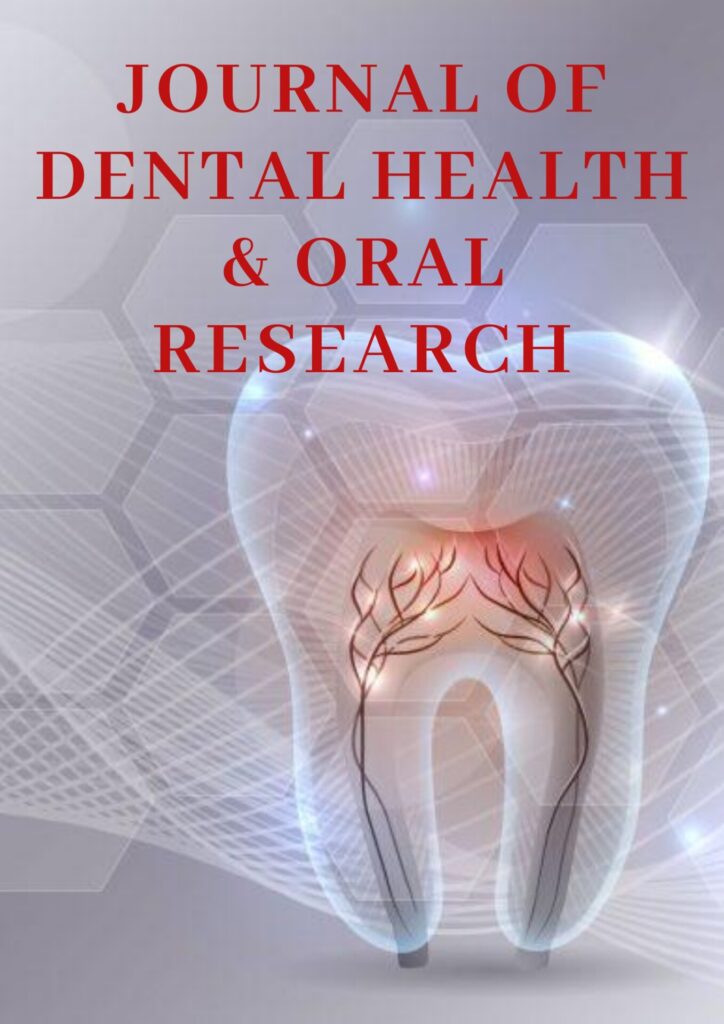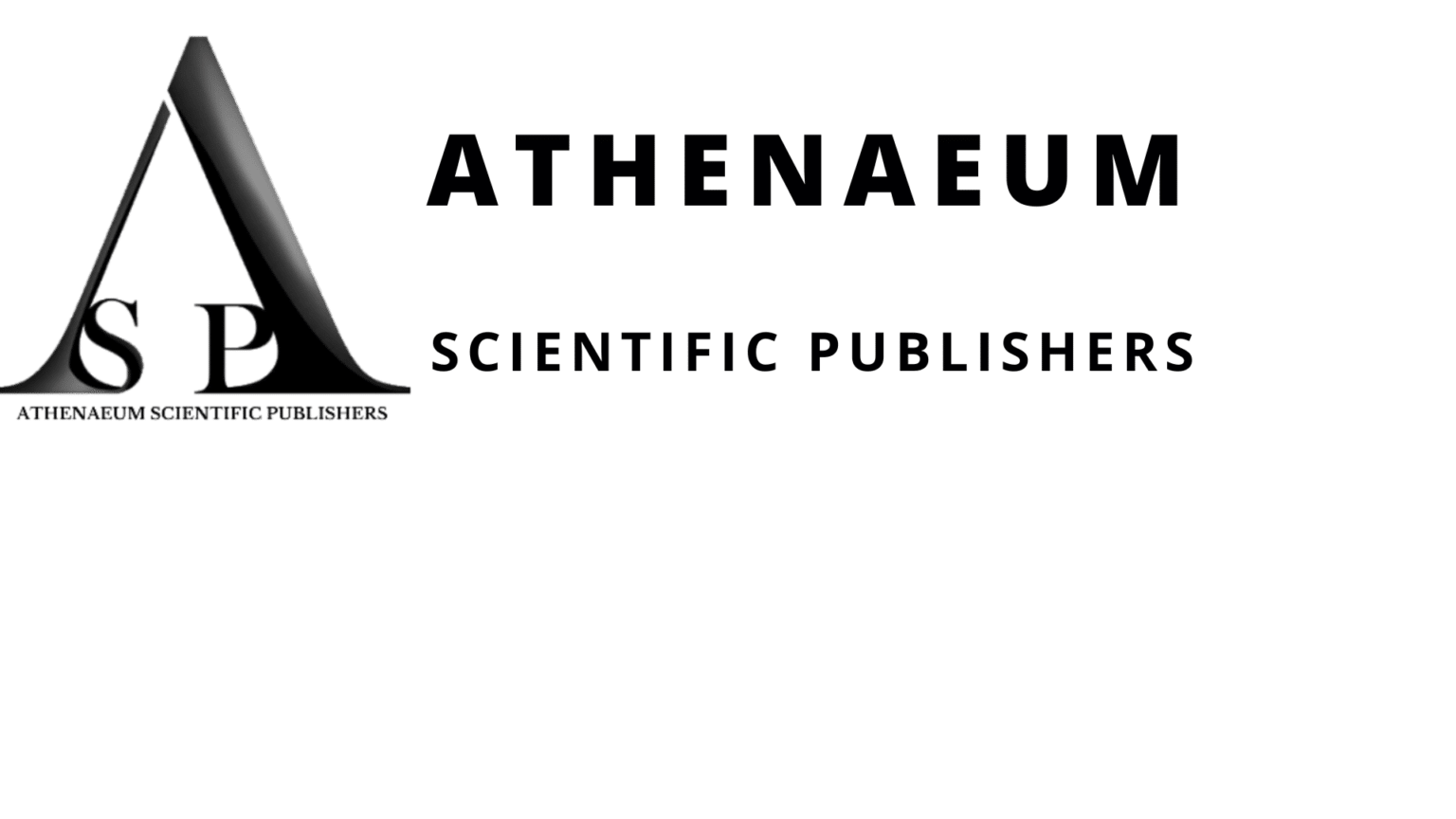Research Article | Vol. 6, Issue 1 | Journal of Dental Health and Oral Research | Open Access |
Features of Mineralization of Hard Tissues of the Tooth in Carious and Non-Carious Lesions
MT Alexandrov1*, EE Altynova1, LA Mamedova1, AA Bashtovoy2, SG Mikhailovskiy3, AV Pilipenko1, AA Zubko1
1Moscow Regional Clinical Research Institute, Russia
2Central State Medical Academy of the Presidential Administration of the Russian Federation, Russia
3OMSKY State Medical University, Russia
*Correspondence author: Mikhail Timofeevich Alexandrov, Moscow Regional Clinical Research Institute, Russia;
E-mail: [email protected]
Citation: Alexandrov MT, et al. Features of Mineralization of Hard Tissues of the Tooth in Carious and Non-Carious Lesions. J Dental Health Oral Res. 2025;6(1):1-9.
Copyright© 2025 by Alexandrov MT, et al. All rights reserved. This is an open access article distributed under the terms of the Creative Commons Attribution License, which permits unrestricted use, distribution, and reproduction in any medium, provided the original author and source are credited.
| Received 04 March, 2025 | Accepted 24 March, 2025 | Published 31 March, 2025 |
Abstract
Relevance: Rehabilitation of patients undergoing orthodontic treatment with subsequent detection of foci of enamel demineralization is one of the leading problems of modern orthodontics.
Materials and methods: 90 patients were monitored, divided into 6 groups: 1 – patients with intact teeth, 2 – with enamel demineralization after removal of braces, 3 – with wedge-shaped defects, 4 – with dental fluorosis, 5 – with pathological erasure, 6 – patients with enamel hypoplasia. Mineralization indicators were determined both at the intact point (the object of comparison) and in the area of its violation (the object of observation).
Results: In patients of group 1, mineralization indices were 60.5-62.1 relative units, group 2- 60.5 intact area-53 demineralization area after removal of braces, group 3 – 84.5 intact -72 relative units in the area of demineralization of the wedge-shaped defect, group 4 – 113.6 -113.7 relative units, group 5 -199.1 intact site-72.6 relative units with pathological erasure, group 6-84,1 intact-66.7 areas of hypoplasia. 60-90 patients with demineralization of hard tooth tissues with initial caries, enamel hypoplasia, wedge-shaped defects, foci of fluorosis and increased erasure using the digital method of raman-fluorescence diagnostics revealed a statistically significant decrease in mineralization by 10-300% relative to intact tooth areas, with indicators: for intact teeth 60.5-62.1 relative units, for initial caries 60.5-53 relative units, for a wedge-shaped defect 84.5-72 relative units, for foci of fluorosis 111.6-113 relative units, for teeth with increased abrasion, 199.1-72.6 relative units in the foci. The decrease was in all cases except for teeth with fluorosis, where it was almost 2 times higher than in intact teeth and 3 times higher for teeth with increased abrasion. Based on the results obtained, a clinical algorithm for assessing the mineralization of dental hard tissues using the method of Raman-fluorescence diagnostics has been developed.
Conclusion: A statistically significant decrease in the mineralization of the hard tissues of the tooth in their non-carious lesions was revealed by 10-300% in relation to intact teeth. The decrease in indicators was in all cases except for teeth with fluorosis, where it was initially 2 times higher than the indicators of intact teeth and 3 times higher for teeth with increased abrasion. The developed digital medical technology is a promising medical technique for assessing the condition of hard dental tissues in normal and non-carious conditions, which will contribute to an effective and controlled rehabilitation process for patients with demineralization foci of various etiologies.
Keywords: Mineralization; Demineralization; Braces; Non-Carious Lesions; Wedge-Shaped Defect; Enamel Hypoplasia; Fluorosis; Pathological Abrasion; Raman Fluorescence Technologies
Introduction
The widespread use of braces in modern dental practice makes it difficult to care for teeth and oral cavity, as a result of which not only their hygienic condition worsens, but also a parameter such as the mineralization level of dental hard tissues decreases below the norm [1, 2]. At the same time, the use of these systems in patients with concomitant pathology remains an insufficiently studied issue. Non-carious lesions of the hard tissues of the teeth. However, in such patients, mineralization processes are pathogenetically disrupted, therefore, the need for monitoring and quantifying this indicator is obvious in order to exclude undesirable complications such as the development of caries, manifestations of hyperesthesia [3-6].
In this regard, we drew attention to the Raman-fluorescence diagnostic method, which allows us to quickly assess the mineralization of dental hard tissues and, based on them, develop a method for the prevention of mineralization disorders in patients with non-carious lesions of dental hard tissues, including when using braces [7].
Until now, the parameter in question is most often determined visually, subjectively and not quantitatively, which does not allow an objective assessment of the processes of de- and remineralization. The visual assessment methods used in dentistry have an error in the range of 200-800% [8-10].
In connection with the above, the concept of the presented scientific work is presented as follows: substantiation of the use of raman-fluorescent technologies for assessing the mineralization of hard dental tissues in non-carious lesions and identification of its sensitivity and clinical effectiveness.
Purpose to develop a method for differential diagnosis of demineralization foci after removal of braces and non-carious lesions of hard tissues of the tooth based on the use of digital Raman fluorescence technologies.
Ethics Approval
This study was approved by the Ethics Committee of Navodaya Dental College and Hospital, Raichur (IEC/NDC/RCR/2023-2024/SSO025).
Materials and Methods
The study was conducted in groups of patients (cohorts) who voluntarily agreed to take part in it, having manifestations of demineralization of the hard tissues of the teeth after the removal of the braces system. As objects of comparison, groups of patients with a wedge-shaped defect, as well as with hypoplasia, fluorosis and/or increased tooth abrasion were examined. The objects of comparison were used to test the sensitivity of the raman fluorescence diagnostic device. Measurements were carried out in the equatorial area along the axis of the tooth, at an intact point.
According to the diagnosis, the patients were divided into 6 groups, 15 participants each. Group 1 (1.1) included patients with intact teeth (IZ). Group 2 (BS) included patients with demineralization, in whom the mineralization of the hard tissues of the tooth was assessed before (group 2.1) and after the installation of braces (group 2.2) (Fig. 1).
Group 3 (CD) consisted of patients with wedge-shaped defects of the hard tissues of the tooth, in whom the mineralization was assessed in the area of the incisal edge (group 3.1) as the object of comparison and in the area of the pathological site (group 3.2) (Fig. 2).
Group 4 (F) – patients with fluorosis, in whom the mineralization of the hard tissues of the tooth was assessed in the area of the incisal edge (group 4.1) as an object of comparison and in the area of the pathological area (4.2) (Fig. 3).
Group 5 (PS) – patients with increased abrasion of hard tissues of the tooth, in whom their mineralization was assessed in the area of the incisal edge (group 5.1) as an object of comparison and in the area of the pathological site (group 5.2) (Fig. 4).
Group 6 (D) – patients with hypoplasia of the hard tissues of the tooth, in whom the mineralization of the hard tissues of the tooth was assessed in the area of the incisal edge (group 6.1) as an object of comparison and in the area of the pathological site (group 6.2) (Fig. 5).
Thus, the mineralization indicators in all groups of patients reflected the state of mineralization both at the intact point (assessed as an object of comparison) and in the area of its violation (assessed as the main object of observation). The intact and affected areas were determined by comparison indicators and the indicators in the affected area were considered objects of the main group. Demineralization indicators as indicators of the main group were used to test the sensitivity of the Raman-fluorescence diagnostic method.
The experimental and theoretical study was performed using Raman-fluorescence technologies on the INSPECTM laser hardware and software complex (Fig. 6), which fully meets the metrological parameters with diagnostic sensitivity for the integrated concentration of aerobic-anaerobic microbial suspension up to 102 CFU/ml [11].
Measurement of the mineralization of the hard tissues of the tooth was carried out in the study area in a contact-stable manner at least three times, the results obtained were averaged (Fig. 7).
To assess the results in the study groups, methods of simple descriptive statistics were used. The normality of the distribution was assessed by the Shapiro-Wilk test. The statistical significance of the intensity of the Raman glow of reflected light on the enamel of the teeth in the studied groups was determined using the criterion of nonparametric statistics. To characterize the samples, the median mean values and the interquartile spread Me (Q1; Q3). To compare the intensity of luminescence between the intact and pathological areas of the tooth enamel, the Wilcoxon W-test was used. The correlation was determined using the Pearson correlation coefficient. The level of statistical significance in the study was assumed to be equal to 95% (p < 0.05). The final results of the study are presented in the form of tables and graphs.
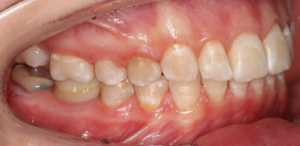
Figure 1: Demineralization of enamel on the vestibular surface of teeth after removal of braces.
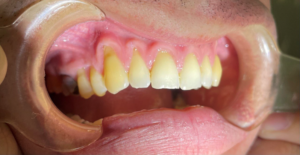
Figure 2: Wedge-shaped defects in the cervical region of the canine and premolars.
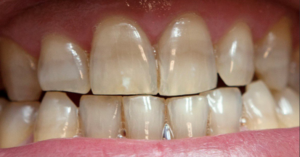
Figure 3: Fluorosis.
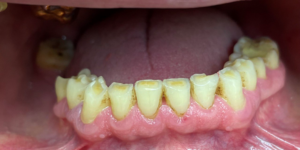
Figure 4: Pathological eras ability.
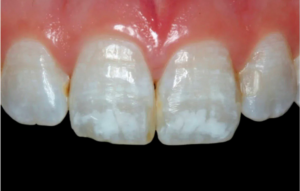
Figure 5: Enamel hypoplasia.
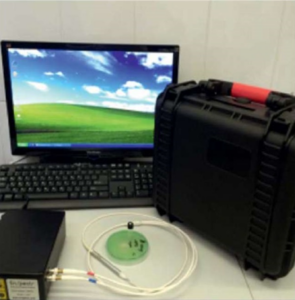
Figure 6: InSpectr M.
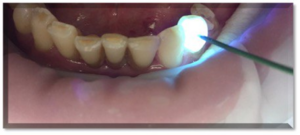
Figure 7: Stage of measuring mineralization of hard dental tissues.
Results
The data presented in Table 1 indicate that the mineralization rates of the hard tissues of the tooth in the intact area are almost always higher than in the pathological one. It is noteworthy that the mineralization indicators of teeth with pathological abrasion in intact areas are much higher than in intact teeth. In patients with fluorosis, it was revealed that in pathological areas with a lower manifestation of fluorosis, mineralization indicators are higher than in areas with a significant manifestation of fluorosis (in this case, in equal proportions) (Table 2).
Groups (in each group n = 15) | Mineralization Indices, M average (relative units) | |
Intact Area
| Pathological Area | |
1.1. Intact teeth (IT) | 60,5 | 62,1 |
2.1-2.2. Intact area – Demineralization (BS) | 60,5 | 53 |
3.1-3.3. Intact area – Wedge-shaped defect (WD) | 84,5 | 72 |
4.1-4.2 Intact area – Fluorosis (F) | 111,6 | 113,7 |
5.1-5.2. Intact area – Increased wearability (IA) | 199,1 | 72,6 |
6.1-6.2. Intact area – hypoplasia (D) | 84,1 | 66,7 |
Note: * – differences between values in the intact and pathological sites having statistical significance calculated according to the Wilcoxon W-test (p < 0.05). The letters on the graph indicate statistically significant differences from the corresponding groups in the intact or pathological area | ||
Table 1: Indicators of mineralization of hard tissues of the tooth in normal and pathological conditions.
Fig. 8 shows that the increase in mean values in the intact and pathological areas increases in the series CD – B – G – F – PS. In the intact area of tooth enamel, the PS group is statically significantly higher than the other studied groups. Groups G and F do not have a statistically significant difference in the intact area, but there is a difference for the pathological site. The NK group does not differ from the G group in the intact and pathological areas. The CD group does not differ from the G group in the intact and pathological areas.
In each group, the intensity values for the pathological site are statistically significantly lower than for the intact site, with the exception of group F. There is a significant difference between the intensity values of the raman for the intact and pathological sites in the PS group. The readings in the intact area are 3 times higher than in the pathological one. To assess the dependence of the intensity of luminescence in the intact and pathological areas, a correlation analysis was carried out.
Group
| Correlation Coefficient
| Statistical Significance, p < 0.05 |
Wedge-shaped defect | – 0,51 | 0,268 |
Demineralized areas (bracket system) | 0,49 | 0,751 |
Hypoplasia | 0,99 * | 3,6.10-12 |
Fluorosis | – 0,87 * | 0,001211244 |
Pathological abrasion | – 0,59 | 0,0745312942 |
Note: * – correlation coefficients of the intensity of the Raman glow for the intact and pathological area of tooth enamel, having statistical significance calculated according to the Fisher criterion (P < 0.05) | ||
Table 2: Correlation coefficients of Raman luminescence intensity for intact and pathological areas of tooth enamel in the studied groups.
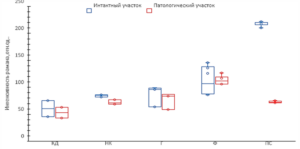
Figure 8: Intensity of Raman luminescence in the intact and pathological areas of the tooth in the study groups: KD – wedge-shaped defect; NK – initial caries; G – hypoplasia; F – fluorosis; PS – pathological abrasion.
Table 2 shows that in group F there is an inverse correlation between the intensity of luminescence in intact and pathological areas of tooth enamel. That is, the decrease in the amount of enamel in the pathological area is inversely proportional to its increase in the intact area. In group G, the indicators in the pathological and intact areas decrease in direct proportion. In the CD, NC and PS groups, the correlation has a pronounced tendency, but has no statistical significance.
The results obtained indicate the high sensitivity of the method of Raman diagnostics of the degree of mineralization of dental hard tissues in normal and pathological conditions, which determines the possibility of its application in clinical practice based on the use of the hardware and software complex INSPECTM. The results of the study allowed us to formulate the following algorithm for using the hardware and software complex in clinical practice:
- Preparation for the work of the hardware and software complex INSPECTM
- Familiarizing the patient with the proposed procedure, explaining safety precautions and signing the RFD’s informed consent
- Selection of the research object and the area of measurement of the mineralization of the hard tissues of the tooth
- Removal of indicators from intact and pathological areas of the tooth in order to correct them later. At the same time, correction using remineralizing drugs involves an increase in the mineralization of the hard tissues of the tooth in the area of pathological changes
- Registration of indicators for data processing with their subsequent interpretation and recommendations for the patient
Discussion
The data obtained during the study made it possible, based on objective numerical indicators, to determine the degree of mineralization of hard tooth tissues both in normal and non-carious lesions, such as increased tooth wear, wedge-shaped defect, fluorosis and dental hypoplasia. Raman diagnostics of the intact tooth surface and the surface with a pathological focus at its location made it possible to visually and, most importantly, quantify the difference in these indicators online, depending on the type of non-carious lesion by comparison [13-17].
The conducted research proves the effectiveness of the innovative Raman medical technology, confirms its high sensitivity, including for differential diagnosis. Its use in clinical practice is recommended, since today this method is the only medical technology for an objective assessment of the level of both de- and remineralization of dental hard tissues, the indicators of which are one of the main objective assessments in the differential diagnosis of non-carious lesions and initial forms of caries directly in clinical settings.
Conclusion
The use of digital Raman-fluorescence technologies is effective as a diagnostic method in all cases of non-carious lesions of the hard tissues of the tooth and initial carious forms, as it allows to obtain clinically objective quantitative indicators of the degree of de- and remineralization online. Based on the presented studies, an algorithm has been developed for applying the clinical method of Raman-fluorescence diagnostics to assess the mineralization of hard tooth tissues in various non-carious lesions with a view to its subsequent correction. The use of the mathematical method of processing the research material made it possible to objectively assess the features of mineralization of dental hard tissues in various carious and non-carious lesions of dental hard tissues using braces, which will allow for effective and controlled remineralizing therapy.
Conflict of Interest
The authors have no conflict of interest to declare.
Funding
This research did not receive any specific grant from funding agencies in the public, commercial, or not-for-profit sectors.
Reference
- Khabadze ZS, Makeeva IM, Mordanov OS, Nazarova DA. Processing of CT-data by artificial intelligence in the diagnosis of caries and its complications. Problems of Dentistry. 2022;1:78-86.
- Khabadze ZS, Makeeva IM, Mordanov OS, Nazarova DA. Artificial intelligence data processing in the diagnosis of caries and its complications. Problems of Dentistry. 2022;1:78-86.
- Montasser MA, El-Wassefi Na, Taha M. An in vitro study of the potential protection of healthy enamel from demineralization. Progress in Orthodontics. 2015;16:12.
- Bessonova EA, Nurieva NS. Classical and digital approaches to the index assessment of oral hygiene. Dentistry. 2022;101(6):14‑17.
- Zhurbenko VA, Saakian ES, Tishkov DS. The prevalence of noncarious diseases of the oral cavity in modern dentistry. Int J Applied and Basic Research. 2015;4(2):301-0.
- Carlota K, Ortega B, Vasquez-Olmos A, Isaac Sato Berru R, Araiza M. Investigation of demineralized tooth enamel treated with various fluoridated preparations. Progress in orthodontics. 2020;10(5):635-44.
- Martinion S, Bartlett D, Manton D, Martinez-Mier EA, Split S, Avila V. Epidemiology of erosive tooth wear, fluorosis and hypomineralization of the molars in the Americas. Caries Res. 2021;55(1):1-11.
- Alexandrov MT, Podoinikova MN, Yeganyan DG. Evaluation of the mineralization of hard tooth tissues by the method of raman-fluorescent medical technologies under the influence of various physical and chemical factors in patients with normal and carious and non-carious lesions. Russian Dental J. 2023;27(6):521-31.
- Alexandrov MT, Podoinikova MN, Yeganyan DG. The use of combination-fluorescent medical technologies to assess the influence of physical and chemical factors on the mineralization of hard tooth tissues in normal and non-carious lesions. Russian Dental J. 2023;27(6):521-31.
- Chesnokov VA, Chesnokova MG, Nesterova KI, Musienko AI. Assessment of the hygienic condition of the oral cavity in persons with excess body mass index at the stages of orthopedic rehabilitation with removable dentures. Periodontol. 2019;24(3):269-273.
- Chesnokov VA, Chesnokova MG, Nesterova KI, Musienko AI. Hygienic assessment of the oral cavity condition in overweight patients undergoing orthopedic rehabilitation with removable dentures. Parodontologiya. 2019;24(3):269-73.
- Musienko AI, Nesterova KI, Musienko AA. Preventive hygiene measures after reparative osteogenesis in patients with chronic generalized periodontitis. Periodontol. 2019;24(2):179-83.
- Musienko AI, Nesterova KI, Musienko AA. Preventive hygienic measures after restorative osteogenesis in patients with chronic generalized periodontitis. Periodontol. 2019;24(2):179-83.
- Orekhova LIU, Loboda EU, Neizberg DM, Boeva PA, Berezkina IV. Comparative assessment of changes in the ultrastructure of the surface of tooth enamel and dental implants when using air-abrasive methods of surface decontamination with various types of abrasives in the process of occupational hygiene. Periodontol. 2019;24(2):133-9.
- Orekhova LI, Loboda ES, Neizberg DM, Boeva PA, Berezkina IV. Comparative assessment of changes in the ultrastructure of tooth enamel and dental implants by air-abrasive surface treatment in the process of professional oral hygiene. Parodontologiya. 2019;24(2):133-9.
- Patent for invention RU 2526584 dated 08/27/2014, patent for invention RU 2543691 dated 03/10/2015 and subsequent clinical statistics (Resolution No. 6361 dated 06.2011 and No. RZN 2015/2419 dated 05/18/2015).
- Patent for invention RU 2526584 dated 08/27/2014, patent for invention RU 2543691 dated 03/10/2015 and for the needs of clinical dentistry (certificates No. 6361 dated 06.2011 and dated 05/18/2015 № RZN 2015/2419).
Author Info
MT Alexandrov1*, EE Altynova1, LA Mamedova1, AA Bashtovoy2, SG Mikhailovskiy3, AV Pilipenko1, AA Zubko1
1Moscow Regional Clinical Research Institute, Russia
2Central State Medical Academy of the Presidential Administration of the Russian Federation, Russia
3OMSKY State Medical University, Russia
*Correspondence author: Mikhail Timofeevich Alexandrov, Moscow Regional Clinical Research Institute, Russia;
E-mail: [email protected]
Copyright
MT Alexandrov1*, EE Altynova1, LA Mamedova1, AA Bashtovoy2, SG Mikhailovskiy3, AV Pilipenko1, AA Zubko1
1Moscow Regional Clinical Research Institute, Russia
2Central State Medical Academy of the Presidential Administration of the Russian Federation, Russia
3OMSKY State Medical University, Russia
*Correspondence author: Mikhail Timofeevich Alexandrov, Moscow Regional Clinical Research Institute, Russia;
E-mail: [email protected]
Copyright© 2025 by Alexandrov MT, et al. All rights reserved. This is an open access article distributed under the terms of the Creative Commons Attribution License, which permits unrestricted use, distribution, and reproduction in any medium, provided the original author and source are credited.
Citation
Citation: Alexandrov MT, et al. Features of Mineralization of Hard Tissues of the Tooth in Carious and Non-Carious Lesions. J Dental Health Oral Res. 2025;6(1):1-9.

